Drug Classification and Preparation of Clients for Detoxification
VerifiedAdded on 2022/10/04
|24
|5510
|12
Homework Assignment
AI Summary
This assignment delves into the critical aspects of drug classification and client preparation for detoxification, providing a comprehensive overview of various substances and their effects on the central nervous system. It includes detailed classifications of drugs like LSD, opium, vodka, PCP, amphetamines, morphine, Rohypnol, hashish, heroin, cocaine, and magic mushrooms, outlining their impacts, observable user symptoms, and expected physiological and psychological responses during detoxification. The assignment presents multiple case studies involving individuals with substance abuse issues, such as marijuana, heroin, barbiturates, cocaine, and hallucinogens, analyzing their symptoms and the associated withdrawal processes. It also covers the management of alcohol withdrawal, emphasizing the importance of support and understanding for individuals undergoing detoxification. The document incorporates research from sources like Google Scholar and relevant publications, offering insights into the latest therapies and approaches to managing withdrawal symptoms and substance abuse. The assignment's goal is to equip counselors with the knowledge needed to support clients through the detoxification process effectively.
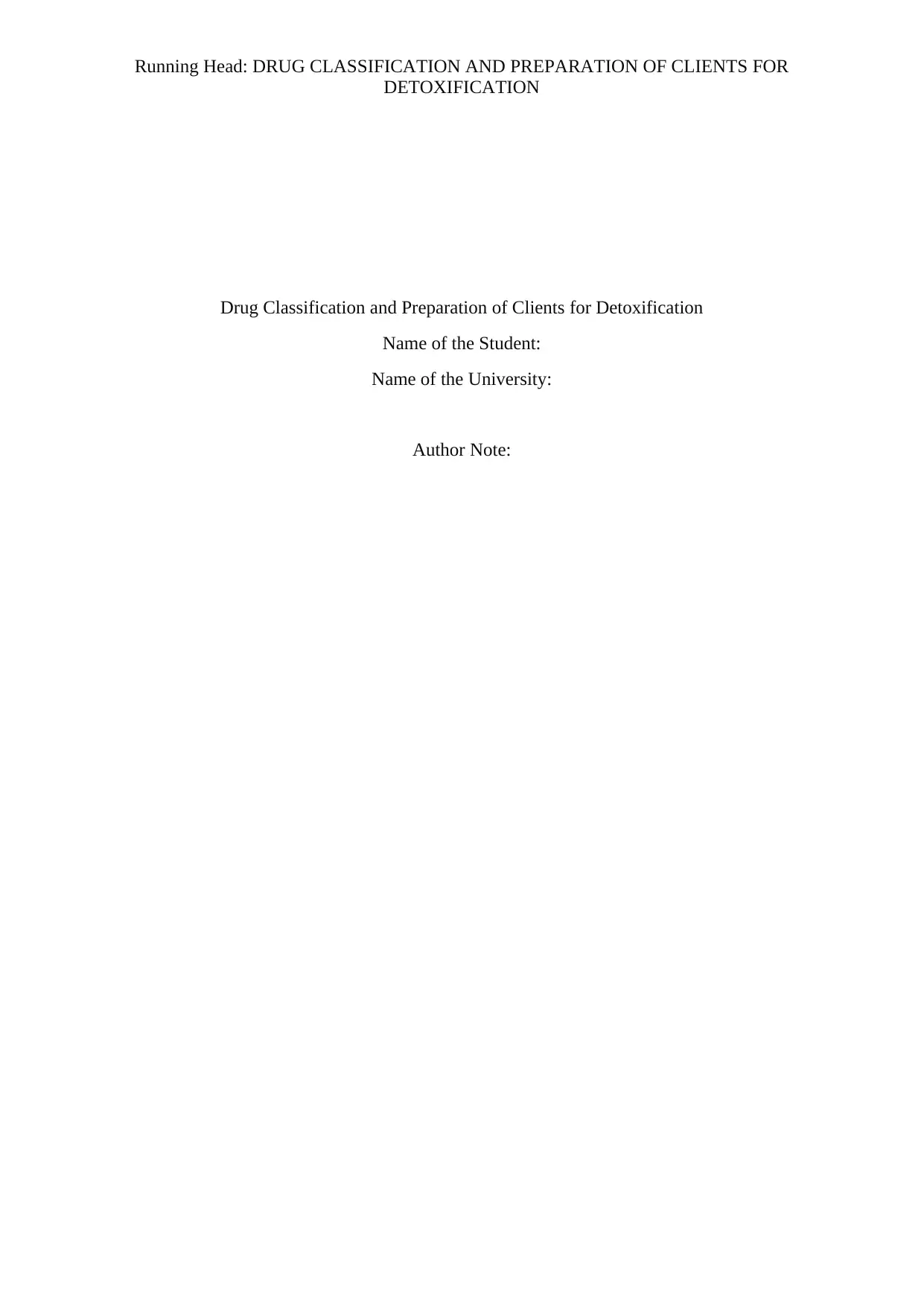
Running Head: DRUG CLASSIFICATION AND PREPARATION OF CLIENTS FOR
DETOXIFICATION
Drug Classification and Preparation of Clients for Detoxification
Name of the Student:
Name of the University:
Author Note:
DETOXIFICATION
Drug Classification and Preparation of Clients for Detoxification
Name of the Student:
Name of the University:
Author Note:
Paraphrase This Document
Need a fresh take? Get an instant paraphrase of this document with our AI Paraphraser
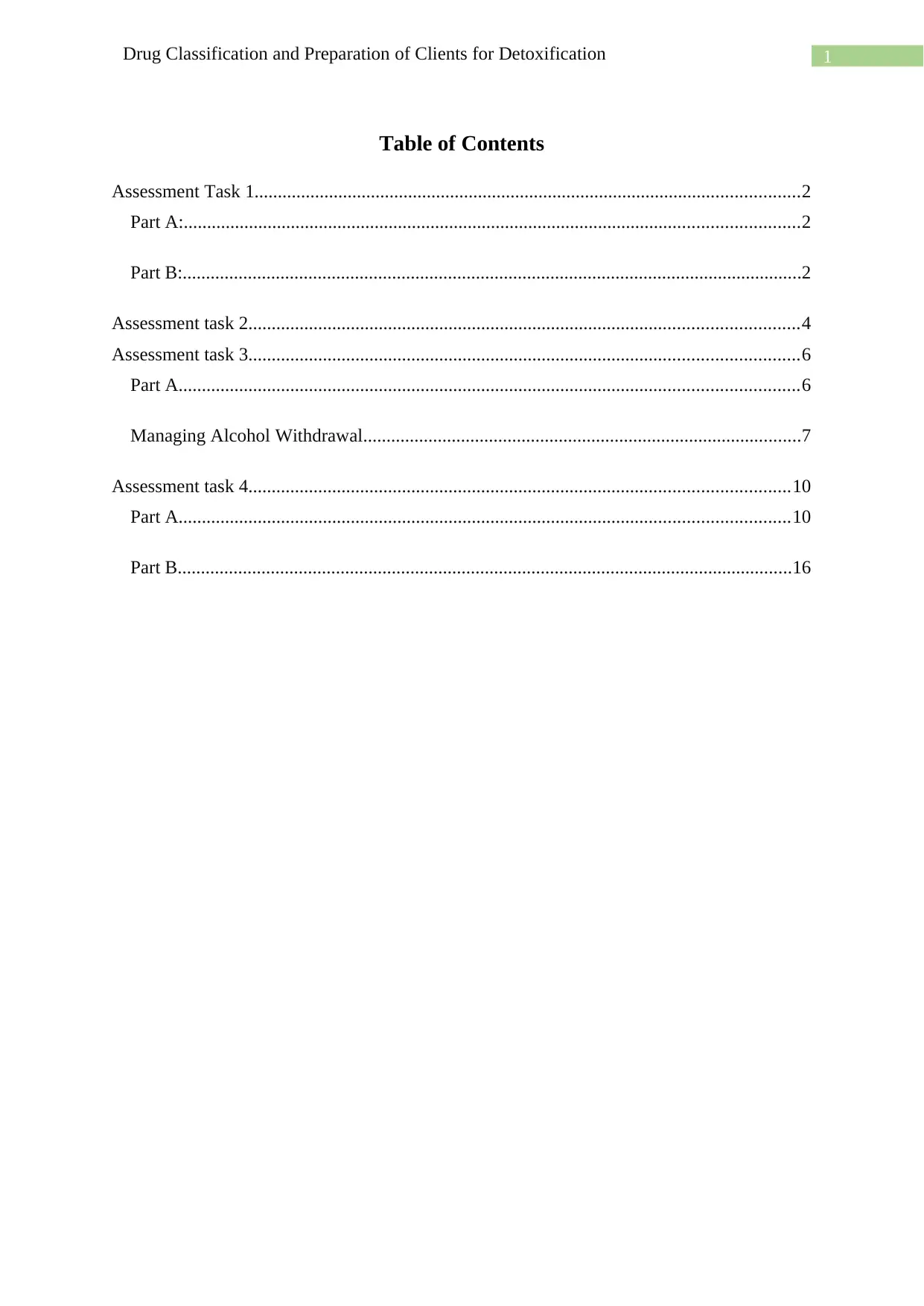
1Drug Classification and Preparation of Clients for Detoxification
Table of Contents
Assessment Task 1.....................................................................................................................2
Part A:....................................................................................................................................2
Part B:.....................................................................................................................................2
Assessment task 2......................................................................................................................4
Assessment task 3......................................................................................................................6
Part A.....................................................................................................................................6
Managing Alcohol Withdrawal..............................................................................................7
Assessment task 4....................................................................................................................10
Part A...................................................................................................................................10
Part B....................................................................................................................................16
Table of Contents
Assessment Task 1.....................................................................................................................2
Part A:....................................................................................................................................2
Part B:.....................................................................................................................................2
Assessment task 2......................................................................................................................4
Assessment task 3......................................................................................................................6
Part A.....................................................................................................................................6
Managing Alcohol Withdrawal..............................................................................................7
Assessment task 4....................................................................................................................10
Part A...................................................................................................................................10
Part B....................................................................................................................................16
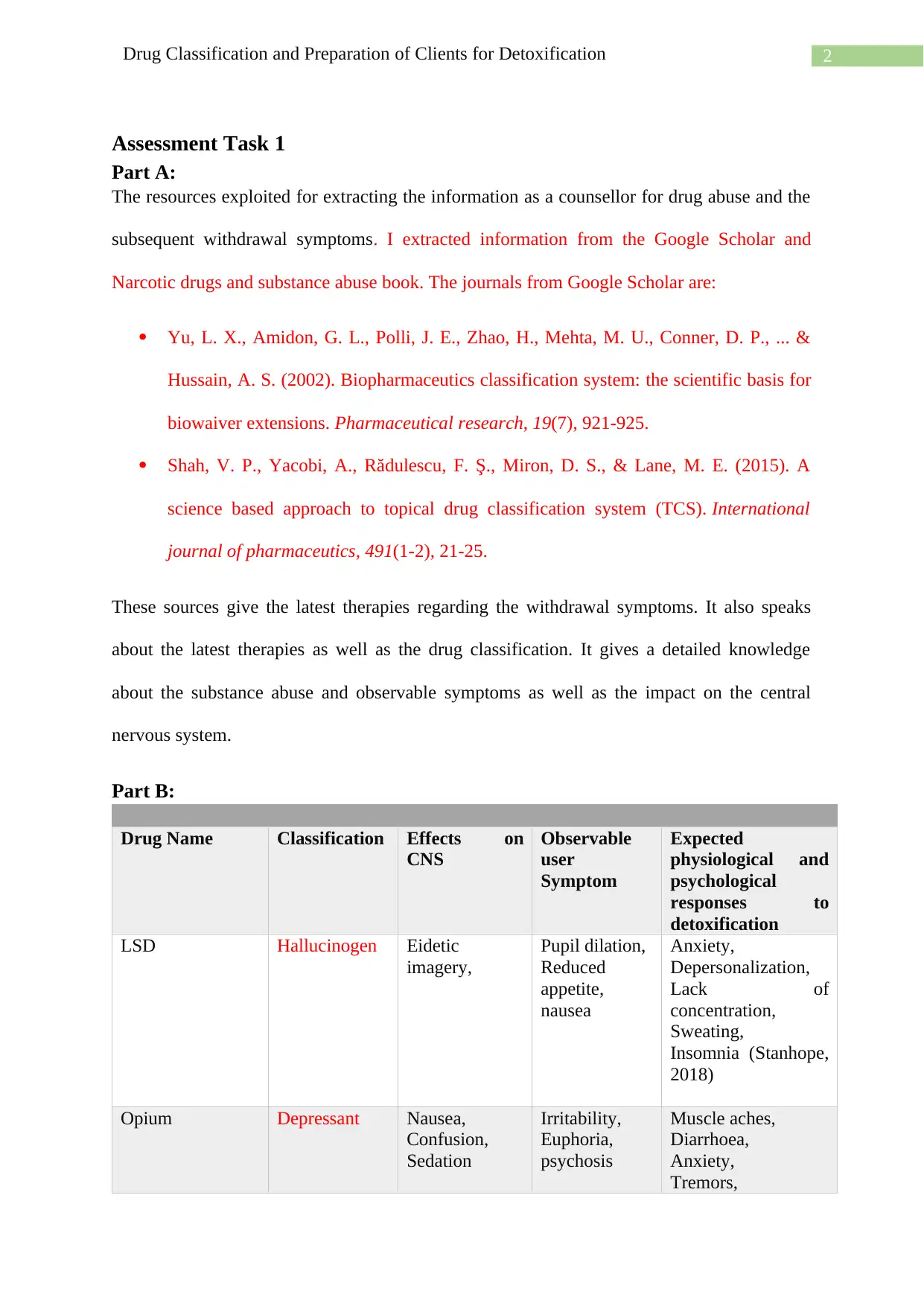
2Drug Classification and Preparation of Clients for Detoxification
Assessment Task 1
Part A:
The resources exploited for extracting the information as a counsellor for drug abuse and the
subsequent withdrawal symptoms. I extracted information from the Google Scholar and
Narcotic drugs and substance abuse book. The journals from Google Scholar are:
Yu, L. X., Amidon, G. L., Polli, J. E., Zhao, H., Mehta, M. U., Conner, D. P., ... &
Hussain, A. S. (2002). Biopharmaceutics classification system: the scientific basis for
biowaiver extensions. Pharmaceutical research, 19(7), 921-925.
Shah, V. P., Yacobi, A., Rădulescu, F. Ş., Miron, D. S., & Lane, M. E. (2015). A
science based approach to topical drug classification system (TCS). International
journal of pharmaceutics, 491(1-2), 21-25.
These sources give the latest therapies regarding the withdrawal symptoms. It also speaks
about the latest therapies as well as the drug classification. It gives a detailed knowledge
about the substance abuse and observable symptoms as well as the impact on the central
nervous system.
Part B:
Drug Name Classification Effects on
CNS
Observable
user
Symptom
Expected
physiological and
psychological
responses to
detoxification
LSD Hallucinogen Eidetic
imagery,
Pupil dilation,
Reduced
appetite,
nausea
Anxiety,
Depersonalization,
Lack of
concentration,
Sweating,
Insomnia (Stanhope,
2018)
Opium Depressant Nausea,
Confusion,
Sedation
Irritability,
Euphoria,
psychosis
Muscle aches,
Diarrhoea,
Anxiety,
Tremors,
Assessment Task 1
Part A:
The resources exploited for extracting the information as a counsellor for drug abuse and the
subsequent withdrawal symptoms. I extracted information from the Google Scholar and
Narcotic drugs and substance abuse book. The journals from Google Scholar are:
Yu, L. X., Amidon, G. L., Polli, J. E., Zhao, H., Mehta, M. U., Conner, D. P., ... &
Hussain, A. S. (2002). Biopharmaceutics classification system: the scientific basis for
biowaiver extensions. Pharmaceutical research, 19(7), 921-925.
Shah, V. P., Yacobi, A., Rădulescu, F. Ş., Miron, D. S., & Lane, M. E. (2015). A
science based approach to topical drug classification system (TCS). International
journal of pharmaceutics, 491(1-2), 21-25.
These sources give the latest therapies regarding the withdrawal symptoms. It also speaks
about the latest therapies as well as the drug classification. It gives a detailed knowledge
about the substance abuse and observable symptoms as well as the impact on the central
nervous system.
Part B:
Drug Name Classification Effects on
CNS
Observable
user
Symptom
Expected
physiological and
psychological
responses to
detoxification
LSD Hallucinogen Eidetic
imagery,
Pupil dilation,
Reduced
appetite,
nausea
Anxiety,
Depersonalization,
Lack of
concentration,
Sweating,
Insomnia (Stanhope,
2018)
Opium Depressant Nausea,
Confusion,
Sedation
Irritability,
Euphoria,
psychosis
Muscle aches,
Diarrhoea,
Anxiety,
Tremors,
⊘ This is a preview!⊘
Do you want full access?
Subscribe today to unlock all pages.

Trusted by 1+ million students worldwide
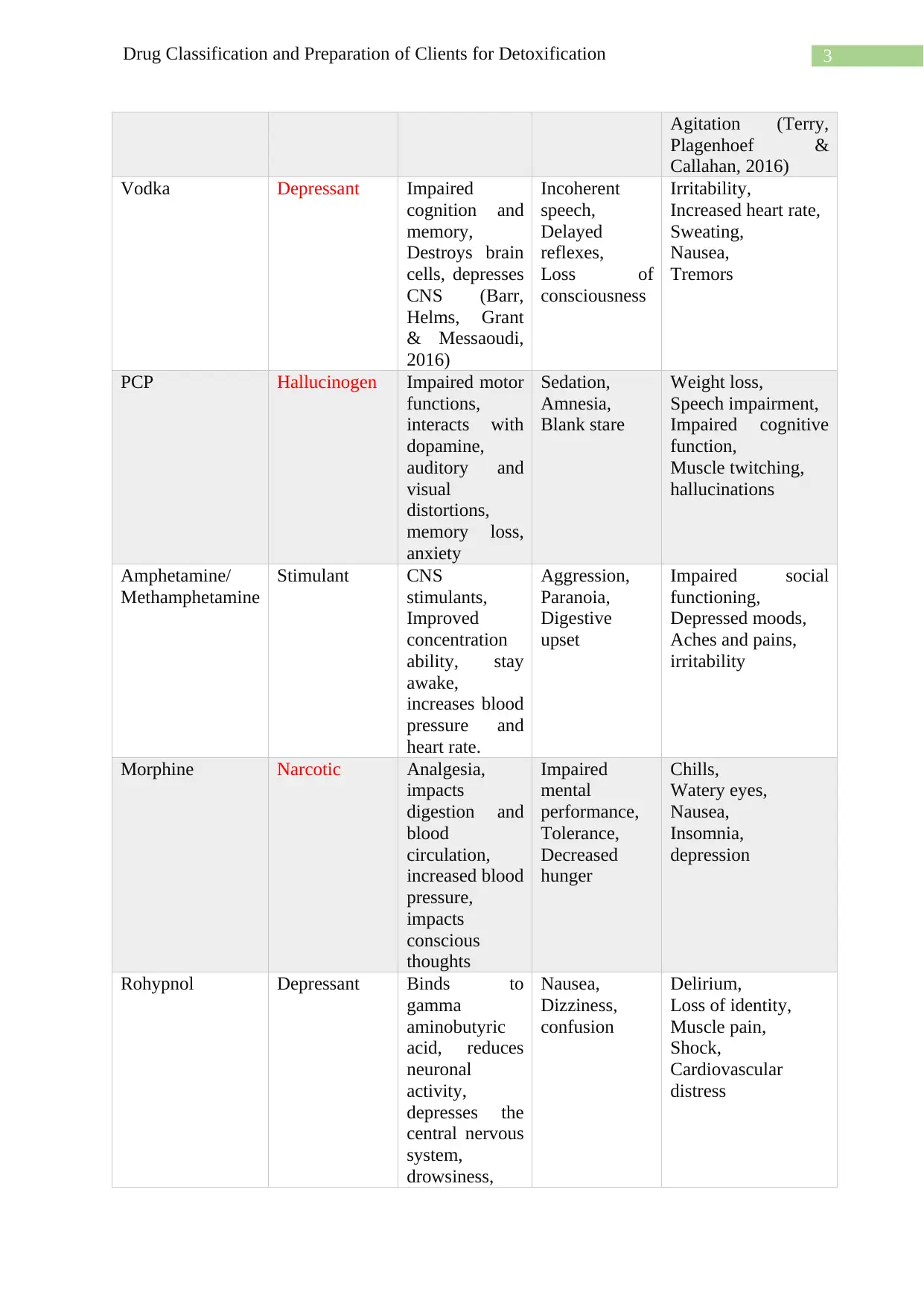
3Drug Classification and Preparation of Clients for Detoxification
Agitation (Terry,
Plagenhoef &
Callahan, 2016)
Vodka Depressant Impaired
cognition and
memory,
Destroys brain
cells, depresses
CNS (Barr,
Helms, Grant
& Messaoudi,
2016)
Incoherent
speech,
Delayed
reflexes,
Loss of
consciousness
Irritability,
Increased heart rate,
Sweating,
Nausea,
Tremors
PCP Hallucinogen Impaired motor
functions,
interacts with
dopamine,
auditory and
visual
distortions,
memory loss,
anxiety
Sedation,
Amnesia,
Blank stare
Weight loss,
Speech impairment,
Impaired cognitive
function,
Muscle twitching,
hallucinations
Amphetamine/
Methamphetamine
Stimulant CNS
stimulants,
Improved
concentration
ability, stay
awake,
increases blood
pressure and
heart rate.
Aggression,
Paranoia,
Digestive
upset
Impaired social
functioning,
Depressed moods,
Aches and pains,
irritability
Morphine Narcotic Analgesia,
impacts
digestion and
blood
circulation,
increased blood
pressure,
impacts
conscious
thoughts
Impaired
mental
performance,
Tolerance,
Decreased
hunger
Chills,
Watery eyes,
Nausea,
Insomnia,
depression
Rohypnol Depressant Binds to
gamma
aminobutyric
acid, reduces
neuronal
activity,
depresses the
central nervous
system,
drowsiness,
Nausea,
Dizziness,
confusion
Delirium,
Loss of identity,
Muscle pain,
Shock,
Cardiovascular
distress
Agitation (Terry,
Plagenhoef &
Callahan, 2016)
Vodka Depressant Impaired
cognition and
memory,
Destroys brain
cells, depresses
CNS (Barr,
Helms, Grant
& Messaoudi,
2016)
Incoherent
speech,
Delayed
reflexes,
Loss of
consciousness
Irritability,
Increased heart rate,
Sweating,
Nausea,
Tremors
PCP Hallucinogen Impaired motor
functions,
interacts with
dopamine,
auditory and
visual
distortions,
memory loss,
anxiety
Sedation,
Amnesia,
Blank stare
Weight loss,
Speech impairment,
Impaired cognitive
function,
Muscle twitching,
hallucinations
Amphetamine/
Methamphetamine
Stimulant CNS
stimulants,
Improved
concentration
ability, stay
awake,
increases blood
pressure and
heart rate.
Aggression,
Paranoia,
Digestive
upset
Impaired social
functioning,
Depressed moods,
Aches and pains,
irritability
Morphine Narcotic Analgesia,
impacts
digestion and
blood
circulation,
increased blood
pressure,
impacts
conscious
thoughts
Impaired
mental
performance,
Tolerance,
Decreased
hunger
Chills,
Watery eyes,
Nausea,
Insomnia,
depression
Rohypnol Depressant Binds to
gamma
aminobutyric
acid, reduces
neuronal
activity,
depresses the
central nervous
system,
drowsiness,
Nausea,
Dizziness,
confusion
Delirium,
Loss of identity,
Muscle pain,
Shock,
Cardiovascular
distress
Paraphrase This Document
Need a fresh take? Get an instant paraphrase of this document with our AI Paraphraser
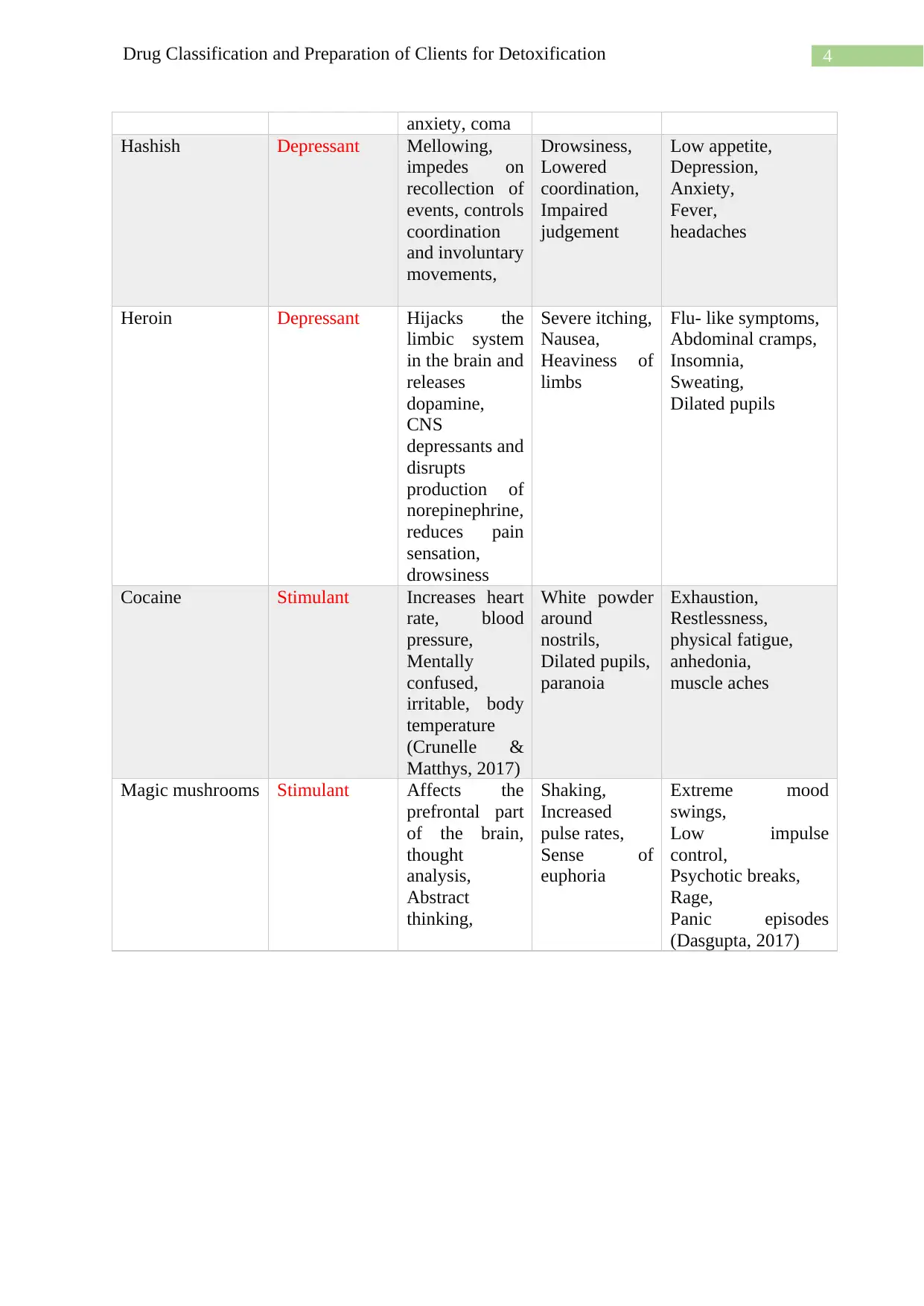
4Drug Classification and Preparation of Clients for Detoxification
anxiety, coma
Hashish Depressant Mellowing,
impedes on
recollection of
events, controls
coordination
and involuntary
movements,
Drowsiness,
Lowered
coordination,
Impaired
judgement
Low appetite,
Depression,
Anxiety,
Fever,
headaches
Heroin Depressant Hijacks the
limbic system
in the brain and
releases
dopamine,
CNS
depressants and
disrupts
production of
norepinephrine,
reduces pain
sensation,
drowsiness
Severe itching,
Nausea,
Heaviness of
limbs
Flu- like symptoms,
Abdominal cramps,
Insomnia,
Sweating,
Dilated pupils
Cocaine Stimulant Increases heart
rate, blood
pressure,
Mentally
confused,
irritable, body
temperature
(Crunelle &
Matthys, 2017)
White powder
around
nostrils,
Dilated pupils,
paranoia
Exhaustion,
Restlessness,
physical fatigue,
anhedonia,
muscle aches
Magic mushrooms Stimulant Affects the
prefrontal part
of the brain,
thought
analysis,
Abstract
thinking,
Shaking,
Increased
pulse rates,
Sense of
euphoria
Extreme mood
swings,
Low impulse
control,
Psychotic breaks,
Rage,
Panic episodes
(Dasgupta, 2017)
anxiety, coma
Hashish Depressant Mellowing,
impedes on
recollection of
events, controls
coordination
and involuntary
movements,
Drowsiness,
Lowered
coordination,
Impaired
judgement
Low appetite,
Depression,
Anxiety,
Fever,
headaches
Heroin Depressant Hijacks the
limbic system
in the brain and
releases
dopamine,
CNS
depressants and
disrupts
production of
norepinephrine,
reduces pain
sensation,
drowsiness
Severe itching,
Nausea,
Heaviness of
limbs
Flu- like symptoms,
Abdominal cramps,
Insomnia,
Sweating,
Dilated pupils
Cocaine Stimulant Increases heart
rate, blood
pressure,
Mentally
confused,
irritable, body
temperature
(Crunelle &
Matthys, 2017)
White powder
around
nostrils,
Dilated pupils,
paranoia
Exhaustion,
Restlessness,
physical fatigue,
anhedonia,
muscle aches
Magic mushrooms Stimulant Affects the
prefrontal part
of the brain,
thought
analysis,
Abstract
thinking,
Shaking,
Increased
pulse rates,
Sense of
euphoria
Extreme mood
swings,
Low impulse
control,
Psychotic breaks,
Rage,
Panic episodes
(Dasgupta, 2017)
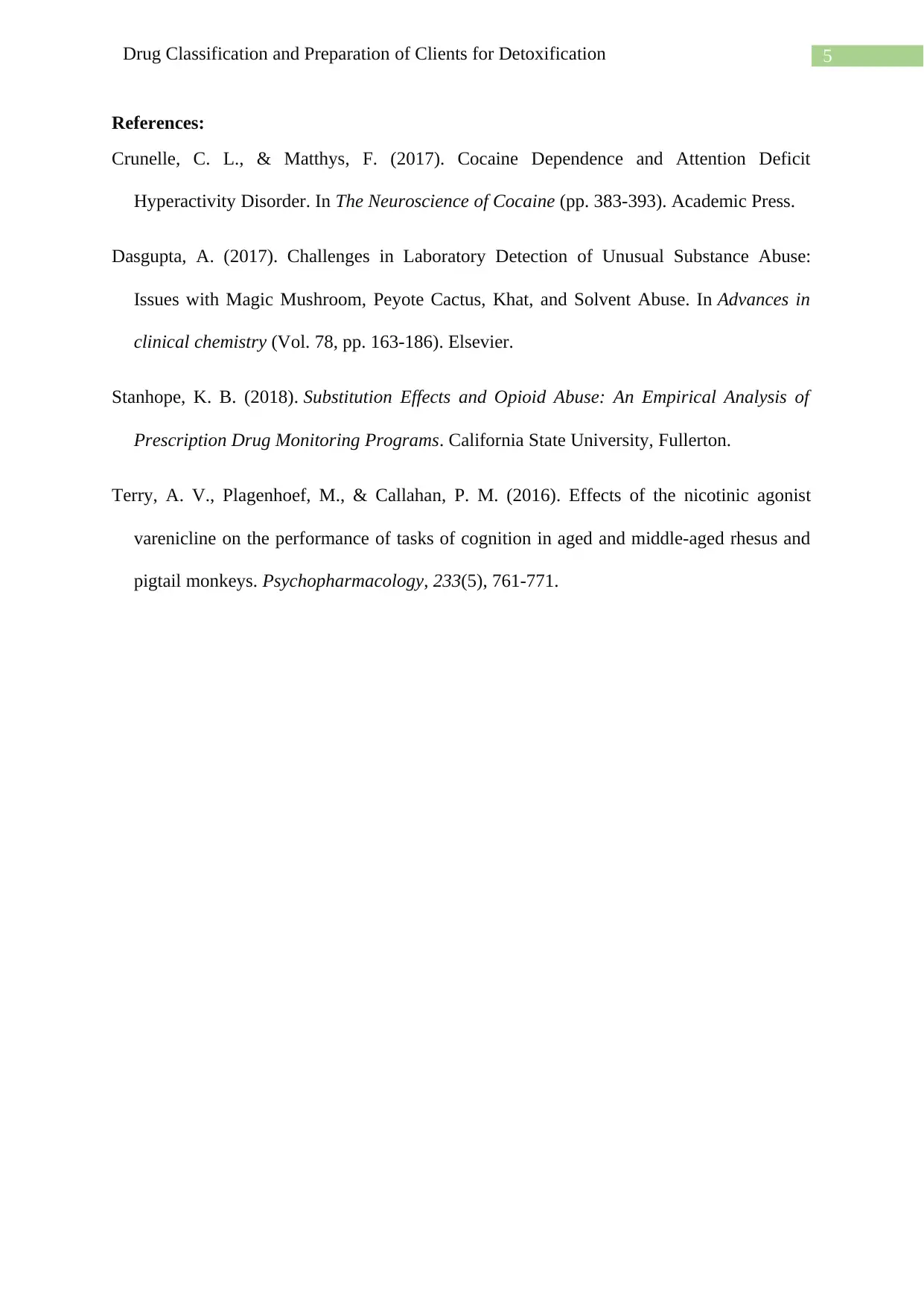
5Drug Classification and Preparation of Clients for Detoxification
References:
Crunelle, C. L., & Matthys, F. (2017). Cocaine Dependence and Attention Deficit
Hyperactivity Disorder. In The Neuroscience of Cocaine (pp. 383-393). Academic Press.
Dasgupta, A. (2017). Challenges in Laboratory Detection of Unusual Substance Abuse:
Issues with Magic Mushroom, Peyote Cactus, Khat, and Solvent Abuse. In Advances in
clinical chemistry (Vol. 78, pp. 163-186). Elsevier.
Stanhope, K. B. (2018). Substitution Effects and Opioid Abuse: An Empirical Analysis of
Prescription Drug Monitoring Programs. California State University, Fullerton.
Terry, A. V., Plagenhoef, M., & Callahan, P. M. (2016). Effects of the nicotinic agonist
varenicline on the performance of tasks of cognition in aged and middle-aged rhesus and
pigtail monkeys. Psychopharmacology, 233(5), 761-771.
References:
Crunelle, C. L., & Matthys, F. (2017). Cocaine Dependence and Attention Deficit
Hyperactivity Disorder. In The Neuroscience of Cocaine (pp. 383-393). Academic Press.
Dasgupta, A. (2017). Challenges in Laboratory Detection of Unusual Substance Abuse:
Issues with Magic Mushroom, Peyote Cactus, Khat, and Solvent Abuse. In Advances in
clinical chemistry (Vol. 78, pp. 163-186). Elsevier.
Stanhope, K. B. (2018). Substitution Effects and Opioid Abuse: An Empirical Analysis of
Prescription Drug Monitoring Programs. California State University, Fullerton.
Terry, A. V., Plagenhoef, M., & Callahan, P. M. (2016). Effects of the nicotinic agonist
varenicline on the performance of tasks of cognition in aged and middle-aged rhesus and
pigtail monkeys. Psychopharmacology, 233(5), 761-771.
⊘ This is a preview!⊘
Do you want full access?
Subscribe today to unlock all pages.

Trusted by 1+ million students worldwide
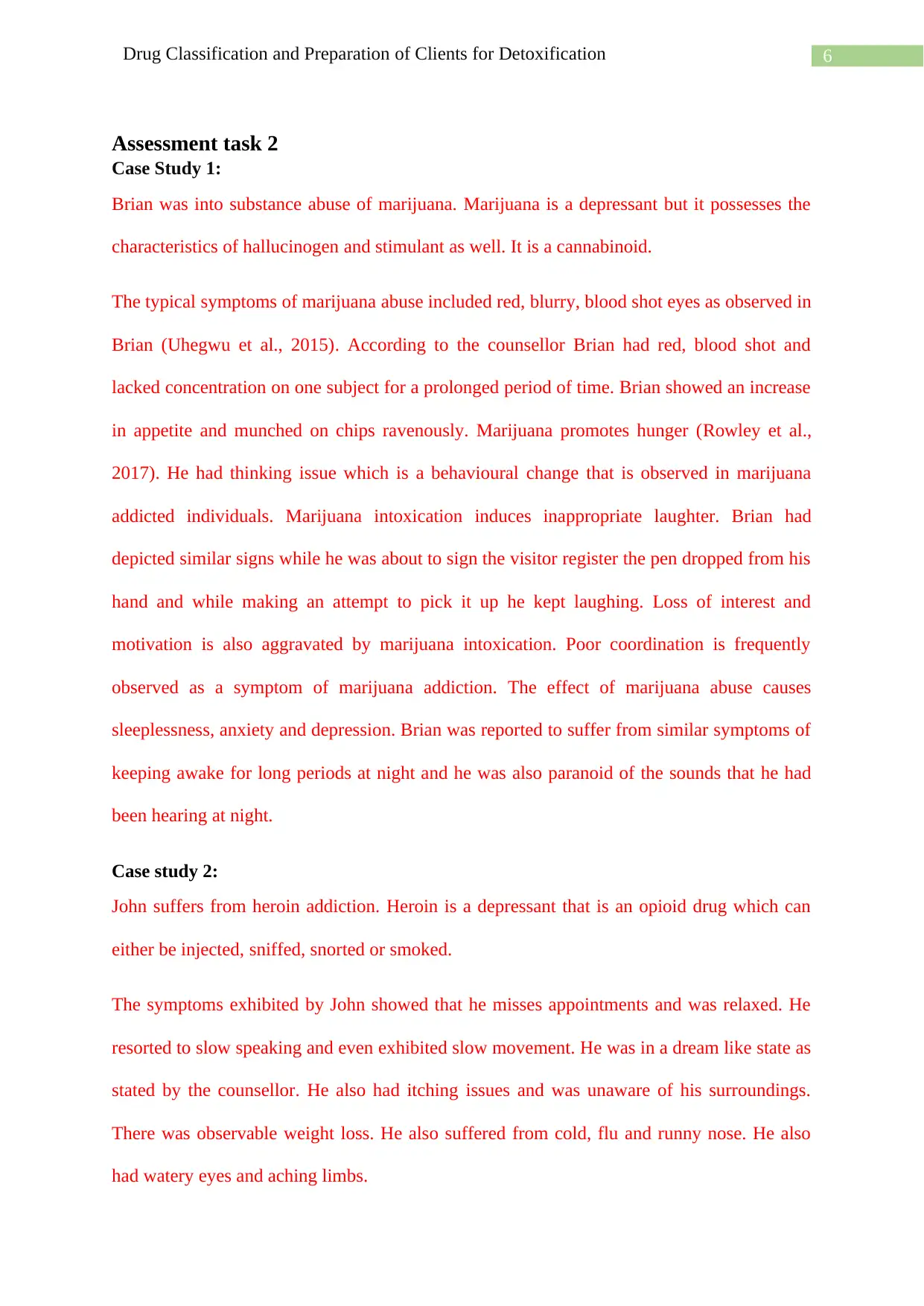
6Drug Classification and Preparation of Clients for Detoxification
Assessment task 2
Case Study 1:
Brian was into substance abuse of marijuana. Marijuana is a depressant but it possesses the
characteristics of hallucinogen and stimulant as well. It is a cannabinoid.
The typical symptoms of marijuana abuse included red, blurry, blood shot eyes as observed in
Brian (Uhegwu et al., 2015). According to the counsellor Brian had red, blood shot and
lacked concentration on one subject for a prolonged period of time. Brian showed an increase
in appetite and munched on chips ravenously. Marijuana promotes hunger (Rowley et al.,
2017). He had thinking issue which is a behavioural change that is observed in marijuana
addicted individuals. Marijuana intoxication induces inappropriate laughter. Brian had
depicted similar signs while he was about to sign the visitor register the pen dropped from his
hand and while making an attempt to pick it up he kept laughing. Loss of interest and
motivation is also aggravated by marijuana intoxication. Poor coordination is frequently
observed as a symptom of marijuana addiction. The effect of marijuana abuse causes
sleeplessness, anxiety and depression. Brian was reported to suffer from similar symptoms of
keeping awake for long periods at night and he was also paranoid of the sounds that he had
been hearing at night.
Case study 2:
John suffers from heroin addiction. Heroin is a depressant that is an opioid drug which can
either be injected, sniffed, snorted or smoked.
The symptoms exhibited by John showed that he misses appointments and was relaxed. He
resorted to slow speaking and even exhibited slow movement. He was in a dream like state as
stated by the counsellor. He also had itching issues and was unaware of his surroundings.
There was observable weight loss. He also suffered from cold, flu and runny nose. He also
had watery eyes and aching limbs.
Assessment task 2
Case Study 1:
Brian was into substance abuse of marijuana. Marijuana is a depressant but it possesses the
characteristics of hallucinogen and stimulant as well. It is a cannabinoid.
The typical symptoms of marijuana abuse included red, blurry, blood shot eyes as observed in
Brian (Uhegwu et al., 2015). According to the counsellor Brian had red, blood shot and
lacked concentration on one subject for a prolonged period of time. Brian showed an increase
in appetite and munched on chips ravenously. Marijuana promotes hunger (Rowley et al.,
2017). He had thinking issue which is a behavioural change that is observed in marijuana
addicted individuals. Marijuana intoxication induces inappropriate laughter. Brian had
depicted similar signs while he was about to sign the visitor register the pen dropped from his
hand and while making an attempt to pick it up he kept laughing. Loss of interest and
motivation is also aggravated by marijuana intoxication. Poor coordination is frequently
observed as a symptom of marijuana addiction. The effect of marijuana abuse causes
sleeplessness, anxiety and depression. Brian was reported to suffer from similar symptoms of
keeping awake for long periods at night and he was also paranoid of the sounds that he had
been hearing at night.
Case study 2:
John suffers from heroin addiction. Heroin is a depressant that is an opioid drug which can
either be injected, sniffed, snorted or smoked.
The symptoms exhibited by John showed that he misses appointments and was relaxed. He
resorted to slow speaking and even exhibited slow movement. He was in a dream like state as
stated by the counsellor. He also had itching issues and was unaware of his surroundings.
There was observable weight loss. He also suffered from cold, flu and runny nose. He also
had watery eyes and aching limbs.
Paraphrase This Document
Need a fresh take? Get an instant paraphrase of this document with our AI Paraphraser
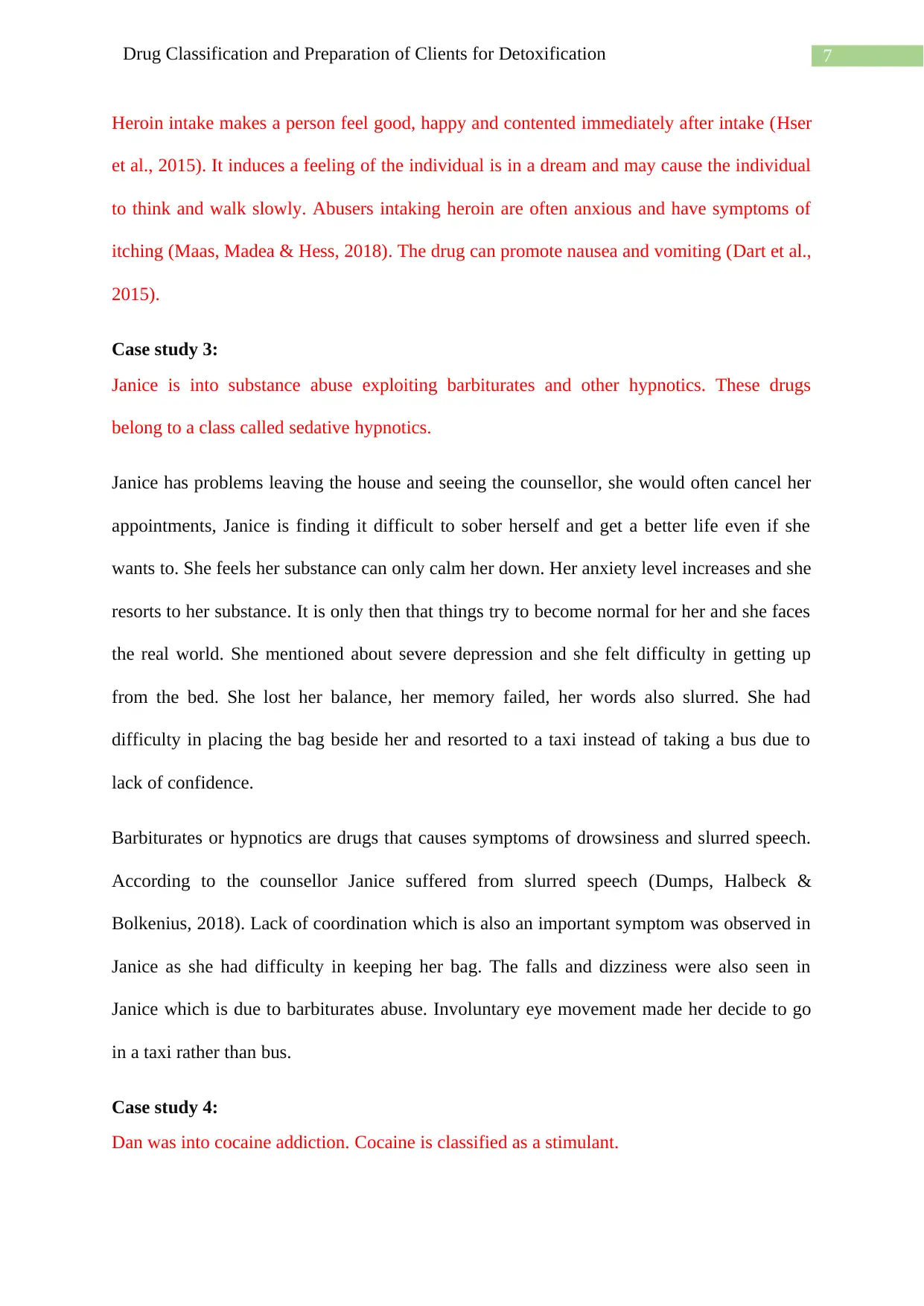
7Drug Classification and Preparation of Clients for Detoxification
Heroin intake makes a person feel good, happy and contented immediately after intake (Hser
et al., 2015). It induces a feeling of the individual is in a dream and may cause the individual
to think and walk slowly. Abusers intaking heroin are often anxious and have symptoms of
itching (Maas, Madea & Hess, 2018). The drug can promote nausea and vomiting (Dart et al.,
2015).
Case study 3:
Janice is into substance abuse exploiting barbiturates and other hypnotics. These drugs
belong to a class called sedative hypnotics.
Janice has problems leaving the house and seeing the counsellor, she would often cancel her
appointments, Janice is finding it difficult to sober herself and get a better life even if she
wants to. She feels her substance can only calm her down. Her anxiety level increases and she
resorts to her substance. It is only then that things try to become normal for her and she faces
the real world. She mentioned about severe depression and she felt difficulty in getting up
from the bed. She lost her balance, her memory failed, her words also slurred. She had
difficulty in placing the bag beside her and resorted to a taxi instead of taking a bus due to
lack of confidence.
Barbiturates or hypnotics are drugs that causes symptoms of drowsiness and slurred speech.
According to the counsellor Janice suffered from slurred speech (Dumps, Halbeck &
Bolkenius, 2018). Lack of coordination which is also an important symptom was observed in
Janice as she had difficulty in keeping her bag. The falls and dizziness were also seen in
Janice which is due to barbiturates abuse. Involuntary eye movement made her decide to go
in a taxi rather than bus.
Case study 4:
Dan was into cocaine addiction. Cocaine is classified as a stimulant.
Heroin intake makes a person feel good, happy and contented immediately after intake (Hser
et al., 2015). It induces a feeling of the individual is in a dream and may cause the individual
to think and walk slowly. Abusers intaking heroin are often anxious and have symptoms of
itching (Maas, Madea & Hess, 2018). The drug can promote nausea and vomiting (Dart et al.,
2015).
Case study 3:
Janice is into substance abuse exploiting barbiturates and other hypnotics. These drugs
belong to a class called sedative hypnotics.
Janice has problems leaving the house and seeing the counsellor, she would often cancel her
appointments, Janice is finding it difficult to sober herself and get a better life even if she
wants to. She feels her substance can only calm her down. Her anxiety level increases and she
resorts to her substance. It is only then that things try to become normal for her and she faces
the real world. She mentioned about severe depression and she felt difficulty in getting up
from the bed. She lost her balance, her memory failed, her words also slurred. She had
difficulty in placing the bag beside her and resorted to a taxi instead of taking a bus due to
lack of confidence.
Barbiturates or hypnotics are drugs that causes symptoms of drowsiness and slurred speech.
According to the counsellor Janice suffered from slurred speech (Dumps, Halbeck &
Bolkenius, 2018). Lack of coordination which is also an important symptom was observed in
Janice as she had difficulty in keeping her bag. The falls and dizziness were also seen in
Janice which is due to barbiturates abuse. Involuntary eye movement made her decide to go
in a taxi rather than bus.
Case study 4:
Dan was into cocaine addiction. Cocaine is classified as a stimulant.
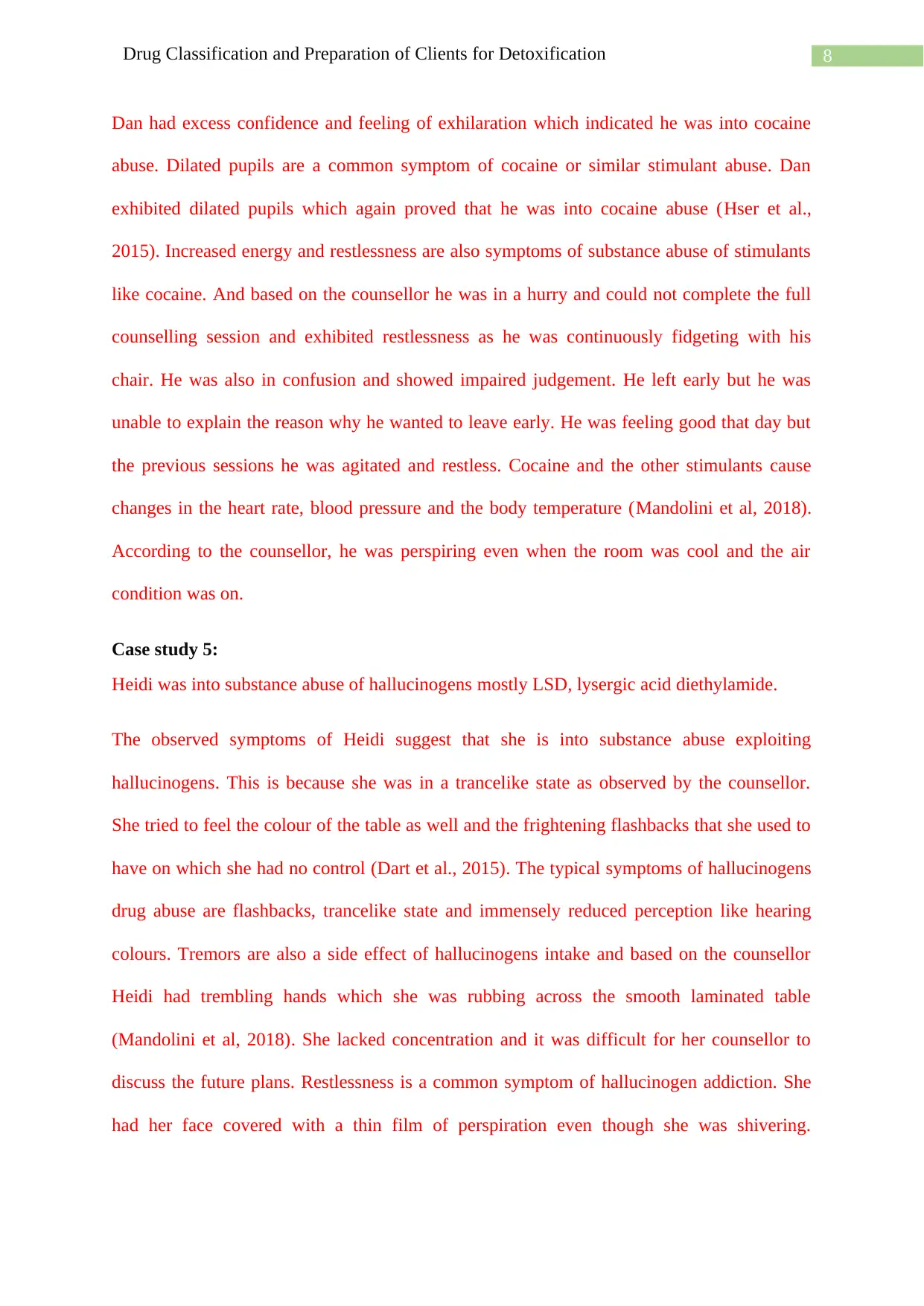
8Drug Classification and Preparation of Clients for Detoxification
Dan had excess confidence and feeling of exhilaration which indicated he was into cocaine
abuse. Dilated pupils are a common symptom of cocaine or similar stimulant abuse. Dan
exhibited dilated pupils which again proved that he was into cocaine abuse (Hser et al.,
2015). Increased energy and restlessness are also symptoms of substance abuse of stimulants
like cocaine. And based on the counsellor he was in a hurry and could not complete the full
counselling session and exhibited restlessness as he was continuously fidgeting with his
chair. He was also in confusion and showed impaired judgement. He left early but he was
unable to explain the reason why he wanted to leave early. He was feeling good that day but
the previous sessions he was agitated and restless. Cocaine and the other stimulants cause
changes in the heart rate, blood pressure and the body temperature (Mandolini et al, 2018).
According to the counsellor, he was perspiring even when the room was cool and the air
condition was on.
Case study 5:
Heidi was into substance abuse of hallucinogens mostly LSD, lysergic acid diethylamide.
The observed symptoms of Heidi suggest that she is into substance abuse exploiting
hallucinogens. This is because she was in a trancelike state as observed by the counsellor.
She tried to feel the colour of the table as well and the frightening flashbacks that she used to
have on which she had no control (Dart et al., 2015). The typical symptoms of hallucinogens
drug abuse are flashbacks, trancelike state and immensely reduced perception like hearing
colours. Tremors are also a side effect of hallucinogens intake and based on the counsellor
Heidi had trembling hands which she was rubbing across the smooth laminated table
(Mandolini et al, 2018). She lacked concentration and it was difficult for her counsellor to
discuss the future plans. Restlessness is a common symptom of hallucinogen addiction. She
had her face covered with a thin film of perspiration even though she was shivering.
Dan had excess confidence and feeling of exhilaration which indicated he was into cocaine
abuse. Dilated pupils are a common symptom of cocaine or similar stimulant abuse. Dan
exhibited dilated pupils which again proved that he was into cocaine abuse (Hser et al.,
2015). Increased energy and restlessness are also symptoms of substance abuse of stimulants
like cocaine. And based on the counsellor he was in a hurry and could not complete the full
counselling session and exhibited restlessness as he was continuously fidgeting with his
chair. He was also in confusion and showed impaired judgement. He left early but he was
unable to explain the reason why he wanted to leave early. He was feeling good that day but
the previous sessions he was agitated and restless. Cocaine and the other stimulants cause
changes in the heart rate, blood pressure and the body temperature (Mandolini et al, 2018).
According to the counsellor, he was perspiring even when the room was cool and the air
condition was on.
Case study 5:
Heidi was into substance abuse of hallucinogens mostly LSD, lysergic acid diethylamide.
The observed symptoms of Heidi suggest that she is into substance abuse exploiting
hallucinogens. This is because she was in a trancelike state as observed by the counsellor.
She tried to feel the colour of the table as well and the frightening flashbacks that she used to
have on which she had no control (Dart et al., 2015). The typical symptoms of hallucinogens
drug abuse are flashbacks, trancelike state and immensely reduced perception like hearing
colours. Tremors are also a side effect of hallucinogens intake and based on the counsellor
Heidi had trembling hands which she was rubbing across the smooth laminated table
(Mandolini et al, 2018). She lacked concentration and it was difficult for her counsellor to
discuss the future plans. Restlessness is a common symptom of hallucinogen addiction. She
had her face covered with a thin film of perspiration even though she was shivering.
⊘ This is a preview!⊘
Do you want full access?
Subscribe today to unlock all pages.

Trusted by 1+ million students worldwide

9Drug Classification and Preparation of Clients for Detoxification
Hallucinogen causes raised body temperature and blood pressure. It causes fast or irregular
heartbeat. She exhibited shallow breathing also.
Hallucinogen causes raised body temperature and blood pressure. It causes fast or irregular
heartbeat. She exhibited shallow breathing also.
Paraphrase This Document
Need a fresh take? Get an instant paraphrase of this document with our AI Paraphraser
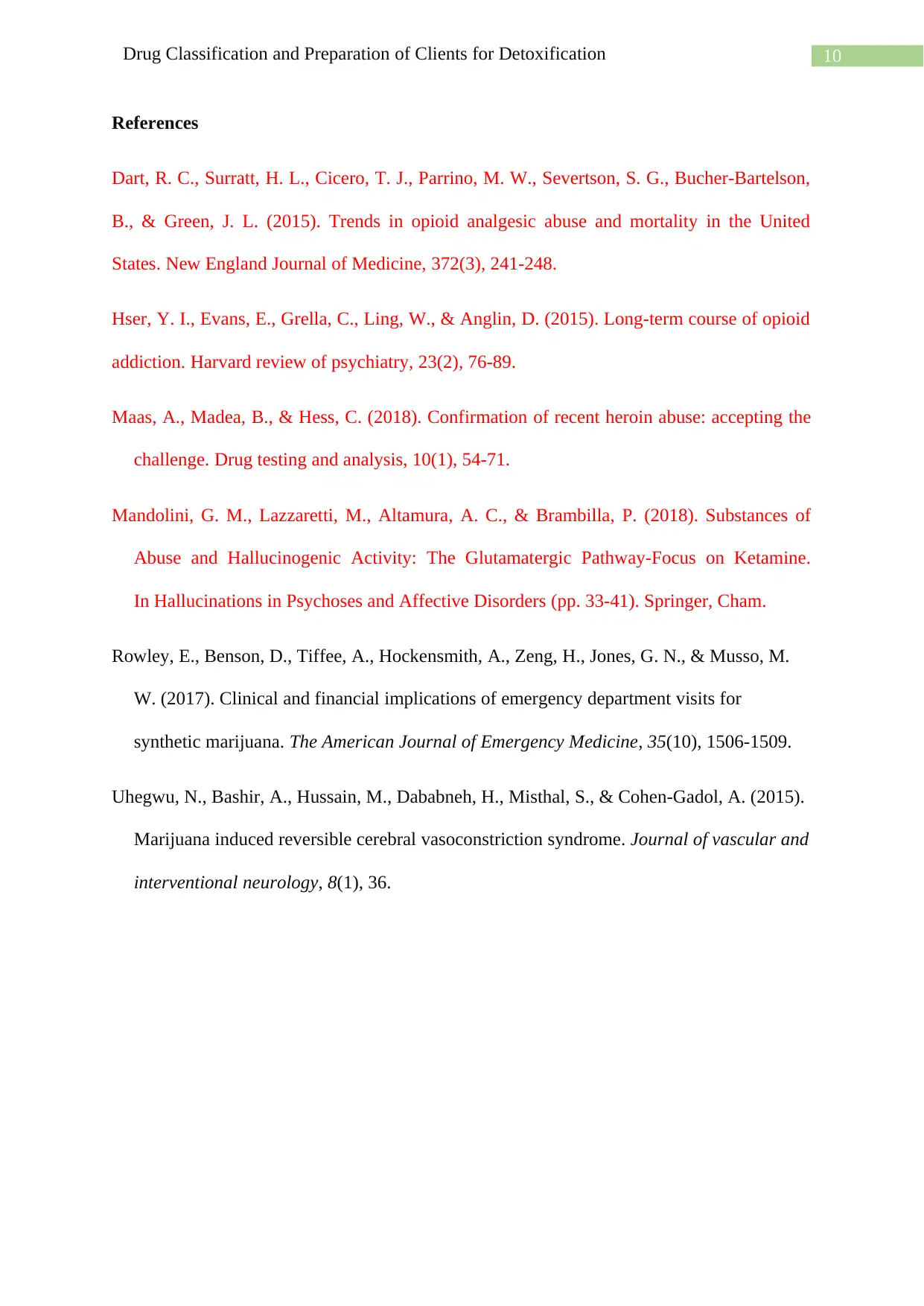
10Drug Classification and Preparation of Clients for Detoxification
References
Dart, R. C., Surratt, H. L., Cicero, T. J., Parrino, M. W., Severtson, S. G., Bucher-Bartelson,
B., & Green, J. L. (2015). Trends in opioid analgesic abuse and mortality in the United
States. New England Journal of Medicine, 372(3), 241-248.
Hser, Y. I., Evans, E., Grella, C., Ling, W., & Anglin, D. (2015). Long-term course of opioid
addiction. Harvard review of psychiatry, 23(2), 76-89.
Maas, A., Madea, B., & Hess, C. (2018). Confirmation of recent heroin abuse: accepting the
challenge. Drug testing and analysis, 10(1), 54-71.
Mandolini, G. M., Lazzaretti, M., Altamura, A. C., & Brambilla, P. (2018). Substances of
Abuse and Hallucinogenic Activity: The Glutamatergic Pathway-Focus on Ketamine.
In Hallucinations in Psychoses and Affective Disorders (pp. 33-41). Springer, Cham.
Rowley, E., Benson, D., Tiffee, A., Hockensmith, A., Zeng, H., Jones, G. N., & Musso, M.
W. (2017). Clinical and financial implications of emergency department visits for
synthetic marijuana. The American Journal of Emergency Medicine, 35(10), 1506-1509.
Uhegwu, N., Bashir, A., Hussain, M., Dababneh, H., Misthal, S., & Cohen-Gadol, A. (2015).
Marijuana induced reversible cerebral vasoconstriction syndrome. Journal of vascular and
interventional neurology, 8(1), 36.
References
Dart, R. C., Surratt, H. L., Cicero, T. J., Parrino, M. W., Severtson, S. G., Bucher-Bartelson,
B., & Green, J. L. (2015). Trends in opioid analgesic abuse and mortality in the United
States. New England Journal of Medicine, 372(3), 241-248.
Hser, Y. I., Evans, E., Grella, C., Ling, W., & Anglin, D. (2015). Long-term course of opioid
addiction. Harvard review of psychiatry, 23(2), 76-89.
Maas, A., Madea, B., & Hess, C. (2018). Confirmation of recent heroin abuse: accepting the
challenge. Drug testing and analysis, 10(1), 54-71.
Mandolini, G. M., Lazzaretti, M., Altamura, A. C., & Brambilla, P. (2018). Substances of
Abuse and Hallucinogenic Activity: The Glutamatergic Pathway-Focus on Ketamine.
In Hallucinations in Psychoses and Affective Disorders (pp. 33-41). Springer, Cham.
Rowley, E., Benson, D., Tiffee, A., Hockensmith, A., Zeng, H., Jones, G. N., & Musso, M.
W. (2017). Clinical and financial implications of emergency department visits for
synthetic marijuana. The American Journal of Emergency Medicine, 35(10), 1506-1509.
Uhegwu, N., Bashir, A., Hussain, M., Dababneh, H., Misthal, S., & Cohen-Gadol, A. (2015).
Marijuana induced reversible cerebral vasoconstriction syndrome. Journal of vascular and
interventional neurology, 8(1), 36.
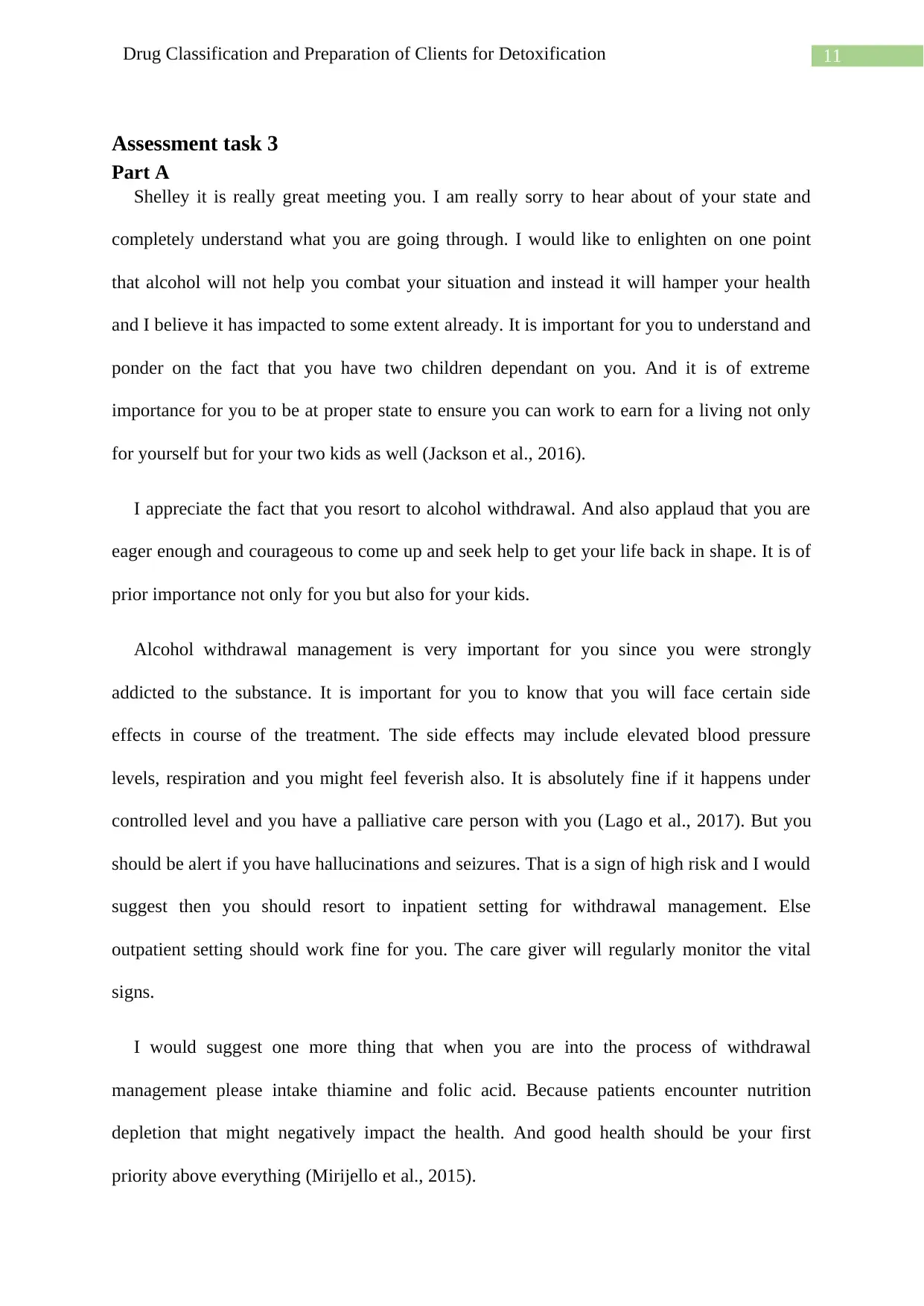
11Drug Classification and Preparation of Clients for Detoxification
Assessment task 3
Part A
Shelley it is really great meeting you. I am really sorry to hear about of your state and
completely understand what you are going through. I would like to enlighten on one point
that alcohol will not help you combat your situation and instead it will hamper your health
and I believe it has impacted to some extent already. It is important for you to understand and
ponder on the fact that you have two children dependant on you. And it is of extreme
importance for you to be at proper state to ensure you can work to earn for a living not only
for yourself but for your two kids as well (Jackson et al., 2016).
I appreciate the fact that you resort to alcohol withdrawal. And also applaud that you are
eager enough and courageous to come up and seek help to get your life back in shape. It is of
prior importance not only for you but also for your kids.
Alcohol withdrawal management is very important for you since you were strongly
addicted to the substance. It is important for you to know that you will face certain side
effects in course of the treatment. The side effects may include elevated blood pressure
levels, respiration and you might feel feverish also. It is absolutely fine if it happens under
controlled level and you have a palliative care person with you (Lago et al., 2017). But you
should be alert if you have hallucinations and seizures. That is a sign of high risk and I would
suggest then you should resort to inpatient setting for withdrawal management. Else
outpatient setting should work fine for you. The care giver will regularly monitor the vital
signs.
I would suggest one more thing that when you are into the process of withdrawal
management please intake thiamine and folic acid. Because patients encounter nutrition
depletion that might negatively impact the health. And good health should be your first
priority above everything (Mirijello et al., 2015).
Assessment task 3
Part A
Shelley it is really great meeting you. I am really sorry to hear about of your state and
completely understand what you are going through. I would like to enlighten on one point
that alcohol will not help you combat your situation and instead it will hamper your health
and I believe it has impacted to some extent already. It is important for you to understand and
ponder on the fact that you have two children dependant on you. And it is of extreme
importance for you to be at proper state to ensure you can work to earn for a living not only
for yourself but for your two kids as well (Jackson et al., 2016).
I appreciate the fact that you resort to alcohol withdrawal. And also applaud that you are
eager enough and courageous to come up and seek help to get your life back in shape. It is of
prior importance not only for you but also for your kids.
Alcohol withdrawal management is very important for you since you were strongly
addicted to the substance. It is important for you to know that you will face certain side
effects in course of the treatment. The side effects may include elevated blood pressure
levels, respiration and you might feel feverish also. It is absolutely fine if it happens under
controlled level and you have a palliative care person with you (Lago et al., 2017). But you
should be alert if you have hallucinations and seizures. That is a sign of high risk and I would
suggest then you should resort to inpatient setting for withdrawal management. Else
outpatient setting should work fine for you. The care giver will regularly monitor the vital
signs.
I would suggest one more thing that when you are into the process of withdrawal
management please intake thiamine and folic acid. Because patients encounter nutrition
depletion that might negatively impact the health. And good health should be your first
priority above everything (Mirijello et al., 2015).
⊘ This is a preview!⊘
Do you want full access?
Subscribe today to unlock all pages.

Trusted by 1+ million students worldwide
1 out of 24
Your All-in-One AI-Powered Toolkit for Academic Success.
+13062052269
info@desklib.com
Available 24*7 on WhatsApp / Email
![[object Object]](/_next/static/media/star-bottom.7253800d.svg)
Unlock your academic potential
Copyright © 2020–2025 A2Z Services. All Rights Reserved. Developed and managed by ZUCOL.

